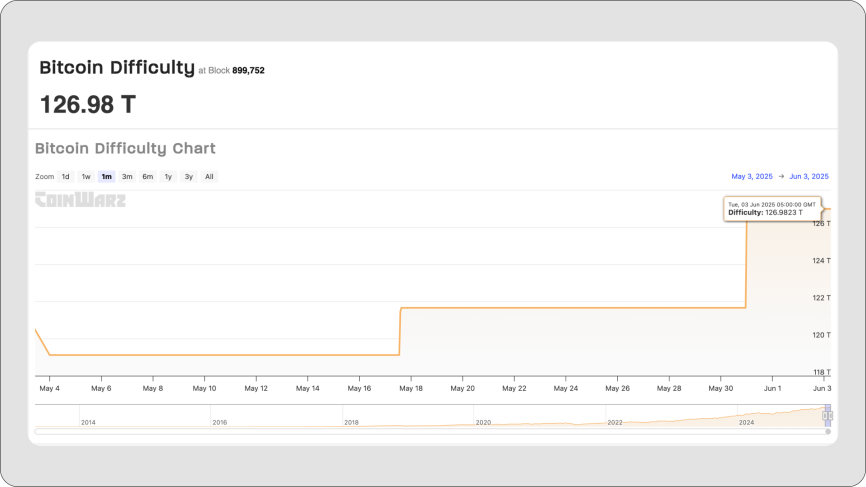What is an ASIC (Application-Specific Integrated Circuit)?
An ASIC is a microchip engineered to perform a single function with maximum efficiency. In cryptocurrency, it refers to a device built to mine one specific algorithm, such as SHA-256 (used by Bitcoin) or Scrypt (used by Litecoin).
Unlike general-purpose CPUs or GPUs, which are suitable for mining many popular coins, ASICs for crypto mining are hardwired to execute only the calculations needed for a specific coin. This specialization delivers superior hash rates and lower energy consumption, which makes ASIC crypto miners the standard for industrial-scale mining.
What role do ASIC miners play in cryptocurrency?
ASIC crypto miners power various cryptocurrency operations. Their fixed-function design enables flash-like speed and energy efficiency, especially for networks like Bitcoin, where mining difficulty is extremely high (123.23T).
Because each ASIC runs a single algorithm with minimal overhead, they process data faster and more reliably than CPUs or GPUs. It ensures stable block production, strong network security, and economic viability even at high difficulty levels.
In modern mining farms, ASICs for crypto are important, as without them, large-scale mining would not be possible.
Why Are ASIC Devices Important for Mining?
Crypto ASIC miners offer high hash rates and low cost per unit of work. Their architecture eliminates unnecessary functions, which allows for faster processing and reduced power consumption.
For example, a single ASIC miner, such as the Bitmain Antminer S19j Pro, delivers around 100 TH/s, while a high-end GPU like the NVIDIA RTX 3080 offers only about 115 MH/s, meaning it would take roughly 1,000 GPUs to match one ASIC’s hash rate.
Additionally, ASIC miners are much more energy-efficient than GPUs because they’re built for a single task – mining one algorithm. For example, the Antminer S19 Pro uses about 3,250 watts to deliver a very high hash rate. In contrast, GPU rigs, like those with six cards, can use 1,200 watts or more but deliver far less mining power, leading to higher electricity costs and lower profits.
As mining difficulty rises, ASIC mining hardware can keep up. These devices ensure that block times stay stable and that the network remains secure and competitive.
How Do ASIC Miners Work?
ASIC mining devices are built around custom chips tailored to one specific mining algorithm.
Each unit contains:
- Controller chips that manage task distribution.
- Firmware that tunes performance and maintains stability.
- High-efficiency power systems for steady operation.
- Cooling systems (air, fans, or liquid) to prevent overheating.
- Ethernet connections for constant internet access.
Operators monitor key metrics such as hash rate, chip temperature, and power draw using built-in interfaces. It allows for continuous optimization and minimizes downtime.
How Are ASICs Used in Cryptocurrency Mining?
ASICs dominate Proof-of-Work mining for coins like Bitcoin and Litecoin. These networks require immense computational power to solve complex hash functions, which ASICs are purpose-built to handle.
As network difficulty increases, general-purpose hardware becomes obsolete. ASIC crypto miners can deliver the speed, energy efficiency, and processing power needed to remain profitable.
Each ASIC model is designed for a specific algorithm. This specialization allows for block confirmation, transaction validation, and network security at scale. Today, most large mining farms rely on crypto-mining ASICs to remain competitive.
What Are the Pros and Cons of ASIC Miners?
Advantages of ASIC mining:
- High performance. Executes one algorithm with extreme speed.
- Energy efficiency. Uses less power per hash than GPUs or CPUs.
- Compact size. Most of them are plug-and-play units.
- Simple setup. There’s no need for complex rigs or external GPUs.
- Stable output. Reliable performance under heavy loads.
Disadvantages of ASIC mining:
- Limited flexibility. Each model supports only one algorithm.
- High upfront cost. Advanced ASICs can be expensive.
- Centralization risk. Large farms dominate due to hardware power.
- Noise and heat. Requires specialized cooling and space.
In general, crypto ASICs provide unmatched mining efficiency. However, they come with trade-offs in flexibility, cost, and decentralization.
Popular ASIC Miner Models
Choosing the right ASICs for crypto mining depends on the algorithm, efficiency, and use case. Below are some of the widely used ASICs for crypto mining on the market today.
- Bitmain Antminer S21 Pro
This air-cooled ASIC crypto miner is optimized for Bitcoin mining. It delivers a top hash rate of 234 TH/s with an impressive energy efficiency of 15 J/TH. The S21 Pro uses the SHA-256 algorithm and consumes 3510W. Released in 2024, it is used mostly by large-scale operations due to its high performance.
- Bitmain Antminer L9
The Antminer L9 is built for Scrypt-based cryptocurrencies like Dogecoin and Litecoin. It offers 16 GH/s and consumes 3360W. With an energy efficiency of 0.21 J/MH, this model stands out in the Scrypt ASICs for the crypto mining segment.
- Bitmain Antminer KS5 Pro
Engineered for the KHeavyhash algorithm, the Antminer KS5 Pro offers 21 TH/s and consumes 3150W. With 150 J/TH energy efficiency, it is a strong choice among crypto ASICs designed for mining Kaspa and similar coins.
- MicroBT Whatsminer M66S Hydro
This hydro-cooled model supports SHA-256 mining. It achieves a hash rate of 298 TH/s at 5513W, with 18 J/TH efficiency. It’s one of the strongest ASICs in crypto mining for those with the infrastructure to support liquid cooling.
- Canaan Avalon A1566
A high-end ASIC for SHA-256, the Avalon A1566 runs at 185 TH/s with a power consumption of 3420W. Its efficiency stands at 18.49 J/TH. Released in 2024, it meets the performance demands of modern crypto-mining operations.
- Iceriver KS5L
Targeting the KHeavyhash algorithm, the Iceriver KS5L delivers 12 TH/s with a power draw of 3400W. It operates at 283.33 J/TH, positioning it among the most efficient mid-range crypto mining ASICs.
- Goldshell AL Box II
Designed for the Blake3 algorithm, the AL Box II is a compact and quiet ASIC crypto machine. It delivers 720 GH/s at only 360W, making it a practical solution for low-noise environments and entry-level mining setups.


